
Discover easy-to-follow herb garden plans tailored for beginners. Learn how to cultivate a thriving herb garden from scratch with our step-by-step guide, perfect for novices looking to add fresh flavours to their culinary creations.
Simple and Effective Herb Garden Plans for Beginners: A Step-by-Step Guide
Mitch Here and im here to help you with your first steps into the world of herb gardening. This isn’t just about planting seeds; it’s about cultivating a rewarding pastime that could spice up your cooking and green up your living space. Imagine having fresh herbs at your fingertips, ready to transform your meals into culinary delights. That’s the joy of herb gardening.
In this introduction, you’re going to find out about the simplicity of starting an herb garden, even if you’ve never touched a trowel in your life. We’ll discuss plans specifically designed for beginners—no overwhelming jargon, just straight, practical advice.
So choose something that resonates with you. Whether you’re looking to enhance the flavors in your kitchen or just wanting to add a little more greenery to your home, I promise, herb gardening is an excellent place to begin your journey into gardening. Get ready to plant the seeds of your new hobby—both literally and figuratively!

Designing Your First Herb Garden: Layouts that Flourish
Now, I’m going to walk you through the thrill of plotting out your first herb garden. The layout you choose is vital to your success. It’s not just about aesthetics; it’s also about creating the conditions that herbs love to grow in.
Consider three popular layouts that are ideal for beginners: container gardens, vertical gardens, traditional bed gardens or Raised Gardens. Container gardens are perfect if you’re short on space or want the flexibility to move your plants around to chase the sun. Vertical gardens are a genius solution for wall space, turning a plain fence into a lush tapestry of greenery. For those with a bit more room, traditional bed gardens spread out horizontally, ensuring plenty of room for your herbs to thrive.
To maximize the health and vitality of your herb garden, regardless of layout, focus on these core elements:
– Adequate drainage to prevent waterlogged roots
– Sufficient sunlight – most herbs bask in full to partial sun
– Quality soil, rich in organic matter, for nutritious growth
– Easy access for watering, harvesting, and tending to your aromatic charges
Remember, you don’t need an expansive plot or a green thumb from the get-go. Small steps and simple plans will soon have your herb garden flourishing. Head over here for An article on the best Organic Fertilizers.
Crafting Your Simple Herb Garden: A Step-by-Step Guide
You’re going to find out just how easy it is to start your own herb garden with this straightforward guide. All you need to begin are a few essential tools, some high-quality soil, seeds or young plants, and water.
First, let’s talk about what you’ll need. A trowel, watering can, pots with drainage holes (if you’re going the container route), and a sunny space are your starting lineup. If you’ve chosen to plant in the ground or in raised beds, make sure you’ve cleared the area of weeds and debris.
Now, onto the step-by-step part. Begin by filling your pots or preparing your soil bed. Herbs love well-draining soil, so if you’re working with heavy soil, consider amending it with some compost or perlite.
Plant your seeds or seedlings according to the instructions on the packet or label. A good rule of thumb is to place taller herbs, like rosemary or dill, towards the back, and shorter ones, like thyme, up front so everything gets enough sun.
Water your new herb garden gently. It’s important to keep the soil moist, especially in the first few weeks while the herbs are establishing their roots. However, you don’t want to overdo it—herbs don’t like to sit in waterlogged soil.
A bit of patience will be required as your herbs begin to grow. During this time, it’s crucial to make sure your plants are getting at least six hours of sunlight each day and are being watered regularly (but not too much).
As your garden grows, you may need to think about routine maintenance like pruning. This encourages fuller, bushier growth and can prevent your herbs from bolting—that is, going to seed too early.
Choose something that resonates with you. With herbs, it isn’t just about utility, it’s also about the enjoyment they provide. Let yourself be guided by your taste buds and curiosity, plant some basil for that pesto you love or mint for a fresh tea. Head over here for an article I wrote and for one of the best Herb Starter Kits

This easy-going approach will flow seamlessly into the next part of your herb-growing journey: finding the perfect herb partners. Understanding which herbs grow best together not only optimizes space but also promotes a healthier garden.
The Starter Herb: Best Options for the Beginner Green Thumb
If you want to dip your toes into the art of herb gardening, you might be wondering, ‘What’s the easiest herb to grow?’ You’re in luck. Some herbs are low-maintenance, making them perfect for beginners. I have a list of herbs and how to grow them over Here.
Basil stands out as a favorite among novices. It grows quickly, providing fragrant leaves that can be used fresh or dried. It thrives in both pots and plots, so regardless of your space, basil can find a home there. Plus, it loves the sun and doesn’t require expert knowledge on soil composition.
Mint is another vibrant contender, famed for its rapid growth and adaptability. It’s so sturdy it can become invasive, so I often suggest planting it in a pot to curb its enthusiasm. It appreciates water, but don’t worry too much about being precise; it’s forgiving.
Chives are not to be overlooked either. They just don’t seem to care about much, handling both drought and frost like champs. Harvesting them is a breeze; a quick snip and you’re done! They’re also known for their lovely lilac blooms, which can add a pop of color to your garden.
I really hope that you choose something that resonates with you. Remember, your first attempt doesn’t need to be your last. Starting with these unfussy herbs will give you the confidence to branch out and experiment with more challenging varieties down the road.
Now, you’re likely thinking about how to group these herbs together, which leads us beautifully into the art of companion planting. You can always adjust your approach down the road, but let’s explore what herbs grow best together in the next section.

Cultivating Synergy: Companions in Your Herb Garden
So now you know what to plant, but what about companion planting? Growing herbs together isn’t just about saving space. It’s about creating a little ecosystem where your plants can support each other. Let’s talk about the allies in the herb world.
Think about basil and tomatoes in the kitchen. They’re perfect together, right? They think so too, even in the garden! Basil is known to improve the flavor of tomatoes, and it’s suggested that it can even deter pests. That’s a win-win in my book.
But it’s not just basil and tomatoes. Consider other combinations like chives and roses to deter aphids, or planting oregano with your peppers to provide general pest protection. These herb companions can reduce the need for chemical interventions, which is better for your health and the environment.
Just be mindful. Not all herbs get along. For instance, keep fennel away from most herbs, as it’s a bit of a bully in the plant world. It’s powerful stuff, and most plants don’t like it, although it’s great for attracting pollinators like butterflies.
In my opinion, the benefits of companion planting in your herb garden can be significant. Not only will you maximize your garden’s efficiency, but you might also enjoy a more bountiful and flavorful harvest. Go ahead and experiment! Nature is quite forgiving, and your first attempt doesn’t need to be your last. Here is another insight into Herbs.
If you’re eager to start your herb garden and you follow these companion planting tips, you’re going to find that your little garden will not only look lovely but also be more resilient and productive. Here’s to the start of a fragrant and flourishing herb adventure!
Leave us any comments
Mitch
Follow to stay up to date with new posts!

Our website contains affiliate links. This means if you click and make a purchase, we may receive a small commission. Don’t worry, there’s no extra cost to you. It’s a simple way you can support our mission to bring you quality Gardening Tips.
Last Updated on February 12, 2025 by Mitch

